You are whom you can credibly claim to be.

Brand identity is the comprehensive expression of your aspirational self-image. Built upon the foundations of smart segmentation, distinctive value proposition, and clear competitive positioning, it is the final step in brand development.

It’s important to remember that your brand’s value ultimately depends on just one thing: the meaning attached to it by the buyers and users in your target market. For these people, this meaning emerges from a slow, steady accumulation of many impressions. These impressions come from your own messaging, the statements of your current and past customers, and the claims made by your competitors (and their current and past customers).
Your messaging is the primary lever you have to positively shape brand meaning.
The work you do to think through and build out your brand identity should yield messaging so artfully developed and executed it controls the narrative.
UC Berkeley marketing professor, David Aaker¹, asserts that a company’s brand identity is made up of four brand dimensions:
- Brand as company
- Brand as product
- Brand as person
- Brand as symbol
For instance, Apple has a developed a “Brand as Company” that celebrates creativity, independence, and empowerment, anchored by the positioning, “Think Different.” Its “Brand as Product” is also distinctive: MacBook, iTunes, iPad and iPhone all feature strong product brands in full alignment with the overall Apple brand. Apple has evoked “Brand as Person” in multiple campaigns over the years — from the Viking woman taking on Big Blue in the 1984 Macintosh commercial, to the “Mac guy vs. PC guy” advertising, to iPod’s dancing silhouettes campaign. And of course, Apple’s library of pitch-perfect logos, icons, color schemes, and typography comprise the company’s “Brand as Symbol.”
Your brand identity must be built to ensure these four brand manifestations are successfully cultivated in the minds of your target audience. At each stage of the prospect and customer journey, your messaging job changes: from creating awareness to building understanding, to establishing relevance, to capturing interest, to building confirmation. Then, after the sale, you must build purchase affirmation and create a confident, happy customer who is happy to recommend your brand to others.
These messaging jobs can be summarized into three major stages of commitment:²
- Vision Lock (“I get what you do and why it’s relevant to me.”)
- Conviction Lock (“I’m convinced. Sign me up!”)
- Advocacy Lock (“I’m a raving fan!”)
Achieving these stages is not simple. Every word and image must be task-focused, brand-true, stage-relevant, and segment-specific. It doesn’t just happen. To get there, it’s helpful to build out a Brand Identity Document.
The Brand Identity Document, discussed in detail below, is the foundation of your Messaging Schema. The messaging schema is the library of playbooks that take messaging to the level of detail necessary to guide daily work. The messaging schema includes between three and six playbooks. For all companies, there are playbooks for Brand, Product Marketing, and Growth Marketing; for those companies that have sales teams, there are three additional playbooks (Sales Development, Account Executives, and Customer Success).
The Brand Identity Document includes your value proposition and competitive positioning statements. It articulates the major supporting themes and product-level statements, data, lists, comparisons, and use cases. It also defines the brand’s visual expression.
The Brand Identity Document has the following structure:
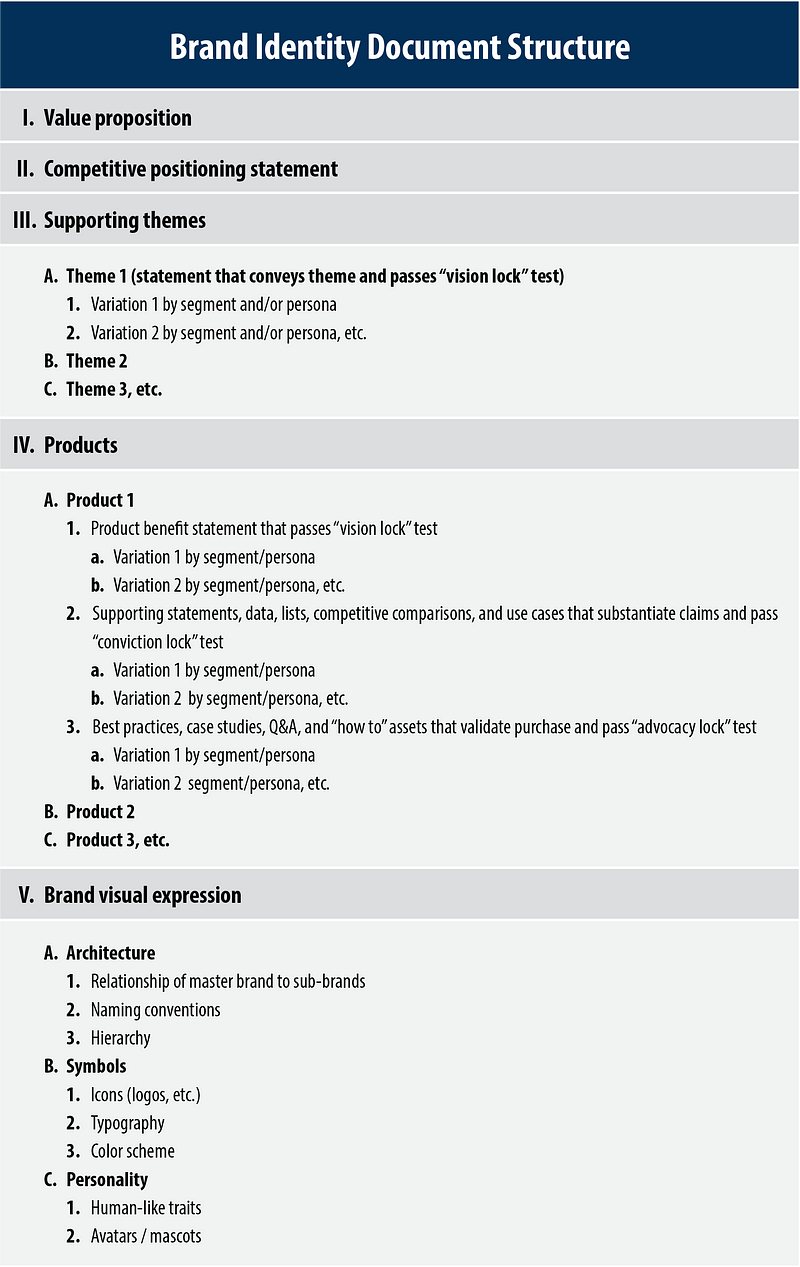
The process to create your brand identity document includes the following steps:
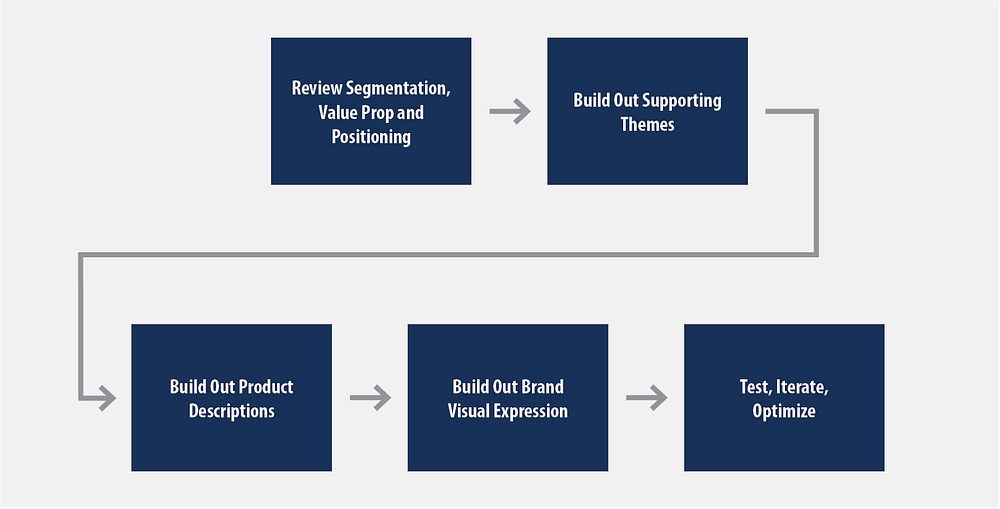
Review Segmentation Data, Value Proposition, and Competitive Positioning
Your value proposition and competitive positioning statement have already been written. So the next step is to develop a short list of supporting themes — the themes that will bolster your competitive positioning statement. Start by pulling together a list of all conceivable themes that could be contenders for the top two to four supporting themes.
This starts by looking over your segmentation data. Within your top priority segments (see Chapter 4, Customer Segmentation), users and buyers have tasks, expectations and pain points. Which ones matter most? Add the most important of these to the themes list.
Next, consider your brand awareness and reputation. With the buyers and users in your top priority segments, how do you fare in terms of aided and unaided brand recall? If you aren’t known at all, you have a big communication challenge but at least you are working with a clean slate. If you are known, what’s your reputation? What attributes do buyers and users associate with your brand? The most frequently recurring positive attributes should be added to the themes list.
Now turn to your value proposition (see Chapter 5, Value Proposition). It is made up of six components:
- For (target customers)
- Who are dissatisfied with (the current market alternative)
- Our product is a (description of product category)
- That provides (compelling reason to buy)
- Unlike (the product alternative)
- We deliver (key whole product features for your specific application)
These components can be converted into themes, such as:
- “We serve SMB businesses”
- “Current expense reporting systems are overbuilt and cumbersome”
- “We’re in the expense reporting market”
- “Our product is simple and user-friendly for small businesses”
- “We’re simpler and cheaper than competitive alternatives”
- “Our scan and display features make expense report submission a breeze”
Use this exercise to tease out additional potential themes and add them to the list.
Now consider your competitive positioning statement (see Chapter 6, Competitive Positioning). Does any other important theme come to mind? Add it to the list as well.
Build Out Supporting Themes
You should now have a fairly comprehensive list of potential themes. Do they naturally group together? Do some themes emerge that most powerfully support and expand upon your competitive positioning statement? Rank them in order of importance. Only the top two to four will make the cut, so choose carefully.
For each chosen theme, turn it into a clear statement that achieves vision lock. Test your choice of themes and theme statements with customers and prospects. Iterate and optimize.
Build out Product Descriptions
Consider each product’s unique value, consistent with the overall company value proposition. Determine the product benefit statement that achieves vision lock.
Sitting underneath the vision lock statement for each product is supporting information. This includes supporting statements, data, lists, competitive comparisons, integration requirements, stories, use cases, price information, the attributes of your team and the level of support you deliver, and so forth. The purpose of this support is to achieve conviction lock.
Finally, these product descriptions will include the content that helps you achieve advocacy lock: documentation of best practices, case studies, Q&A, “How To,” and so forth.
Different segments and personas may require product benefit statement variations. If so, vary accordingly. With prospects and customers, test, iterate and optimize to confirm clarity and resonance.
Brand Visual Expression
Brand Architecture:
Smart brand architecture simplifies and clarifies.
For some companies, brand architecture is irrelevant. The product and company are synonymous. Healthline.com is the health website (the product), and Healthline is the company. But for many tech companies, product features proliferate or new products are added. When this occurs, a well-conceived brand architecture becomes important.
Let’s start with a simple example — the naming hierarchy for a company with a single dominant product that has various configurations or product bolt-ons. You might, for instance, have a Silver, Platinum or Gold offering. Or you might have an updated version of a product — the Pro 2.0 or 3.0, etc.
ClearCare, a platform for home care agencies, matches this description. The company organizes its brand hierarchy starting with ClearCare, the product platform. The platform is presented showing four categories of use: “Grow your Agency,” “Manage Caregivers,” “Deliver Care,” and “Optimize Operations.” Under each category, product features are shown, following a simple descriptive naming convention. In turn, these flow into pricing, as follows:


As you scale, your product line will expand. You may build separate business units. You may acquire companies that bring along brand equity you want to keep. Inevitably, if you are successful, the brand architecture will become more complicated. To solve for these growing complexities, you will need to choose a brand architecture that falls into one of four alternative approaches:
1. Strong Master Brand / Strong Sub-brand
- Sub-brands are strong, but they also have a strong link to the master
- Example: Microsoft

The advantage of this approach is that it ensures the sub-brands are independent, while still leveraging a strong master brand. The risk of this approach is that if the master brand weakens, the sub-brands can suffer. Also, to become strong, each sub-brand requires significant marketing spend.
2. Branded house
- Strong master brand with distinctive but subordinate sub-brands
- Example: Virgin
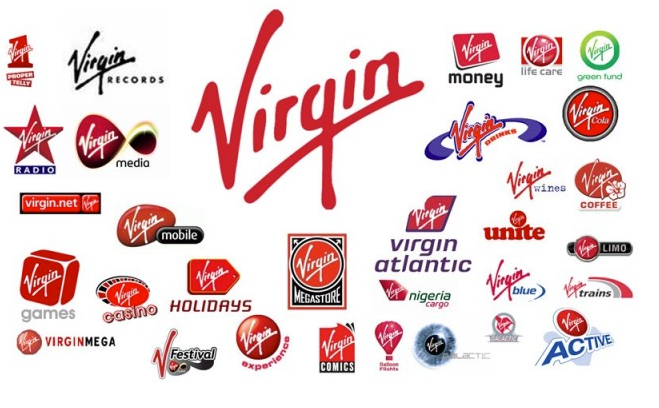
The branded house architecture carries the benefit of marketing efficiency. Marketing spend is focused on building the master brand. Sub-brands are supported but are closely linked to the master brand. Challenges include situations in which the sub-brand can’t break out from under its master, or in a competitive space, the sub-brand might find the master brand more of an anchor than a lever in creating positive differentiation.
3. Endorsed brands
- Brands stand alone but are endorsed by a master brand
- Example: Google

This type of brand architecture delivers the benefit of strong independent brands, while still affording affiliation leverage with a strong master brand. The downside is that each independent brand requires significant independent investment. Also, if the master brand is damaged, there could be negative affiliation risk.
4. House of brands
- Brands stand completely alone; master brand is not visible
- Example: IAC Media
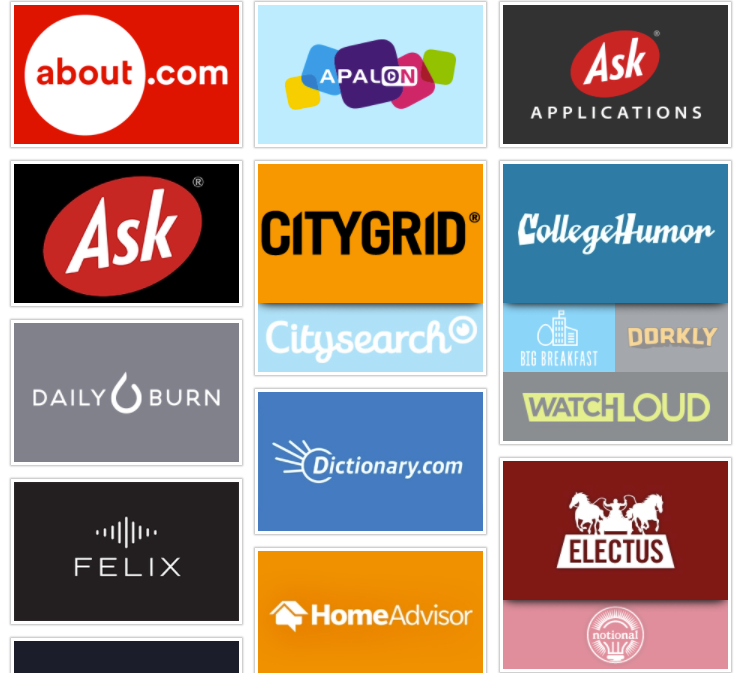
The advantage of this approach is that every brand is completely independent. Each brand can serve disparate markets and segments uniquely with no negative affiliation impacts. On the other hand, the “house of brands” approach requires the highest level of marketing investment. And of course, there’s no leverage from a strong master brand.
The secrets to smart brand architecture are clarity, consistency, and simplicity. Figure out your audience and your purpose, and build a framework that achieves it.
Personality
Leveraging the buyer and user personas you discovered in your customer segmentation work and a deep understanding of the problems you solve, you can express your brand with human-like traits. This is powerful. It makes your brand more accessible and adds emotional and self-expressive benefits to the core functional benefits you deliver.
Brand as Person is closely linked to your internal culture and values. Who you profess to be, expressed in human-like traits, must be aligned with who you are, as seen by your customers in their interactions with you.
List the human-like traits of your brand. Perhaps it’s “cool person” (e.g., Mac) vs. “nerd” (e.g., PC). Or “warm and welcoming.” Or “smart.” Or “creative.”
For an example of a company that does this well, consider Mancrates.com. This e-commerce site for men’s gifts is quintessentially and irreverently “Male.” Guys are pictured with heavy machinery and heavy tools and there’s a tongue-in-cheek “manliness” about the entire site. The company creates a fun, accessible, “manly” ambiance for customers that separates it from the pack.
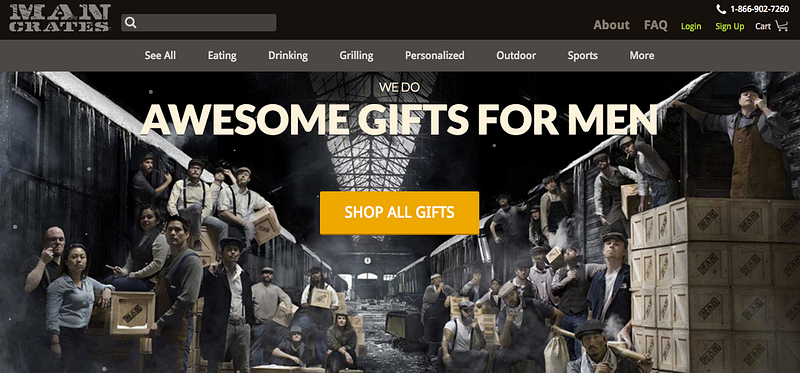
Symbols
Your naming, logo, typography, color scheme, branded images, icons, mascots, and other visual assets comprise your “Brand as Symbol.” These are designed to accentuate the core themes of your brand. What metaphors do you want to invoke? What affiliations? How do they advance your positioning and connect to your top segments and their buyers and users? Choose wisely. Then test, iterate and optimize.
Bringing it All Together
Consider Healthline, one of the most highly visited consumer health websites in the world and the fastest growing in the top four. Its CEO, David Kopp, and his team updated the Healthline brand in 2016.
The team started with a restatement of vision (A stronger, healthier world) and mission (To be your most trusted ally in your pursuit of health and well-being). Their value proposition reads as follows:
For health seekers who want to be well-informed and self-empowered, Healthline is their most valued and trusted resource. Unlike other consumer health information publishers, we provide experiences that pair authoritative, approachable, actionable content with compassion and a commitment to a healthier world.
As part of their work, the team defined the brand’s key themes. These themes inform all content:
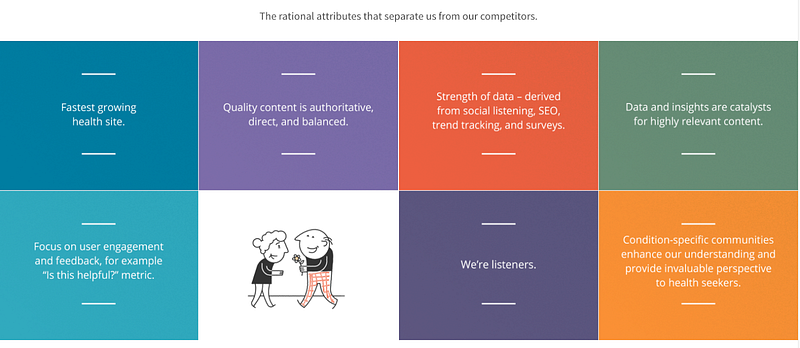
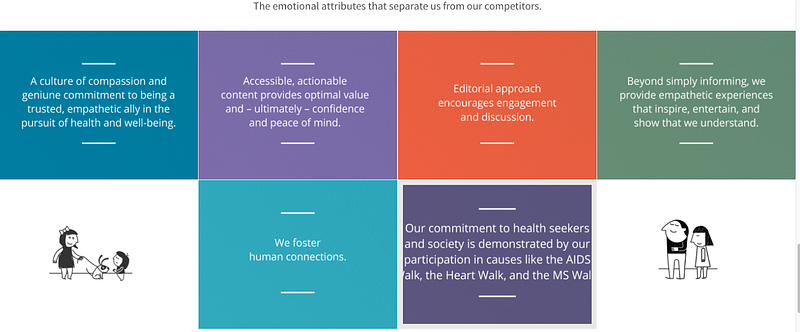
The Healthline personality is described as follows:
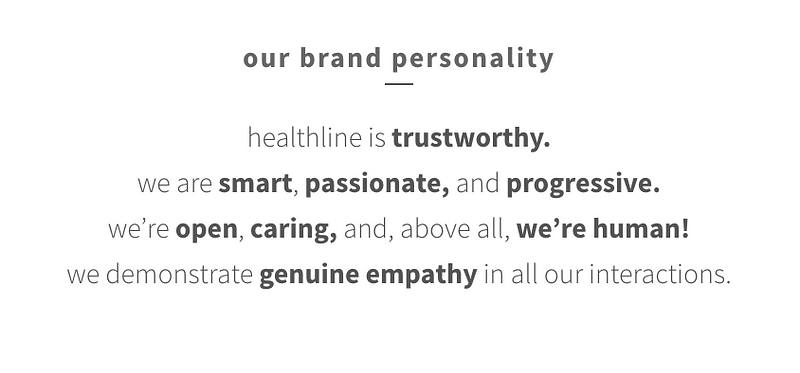
Here’s the logo:

The color palette is as follows:
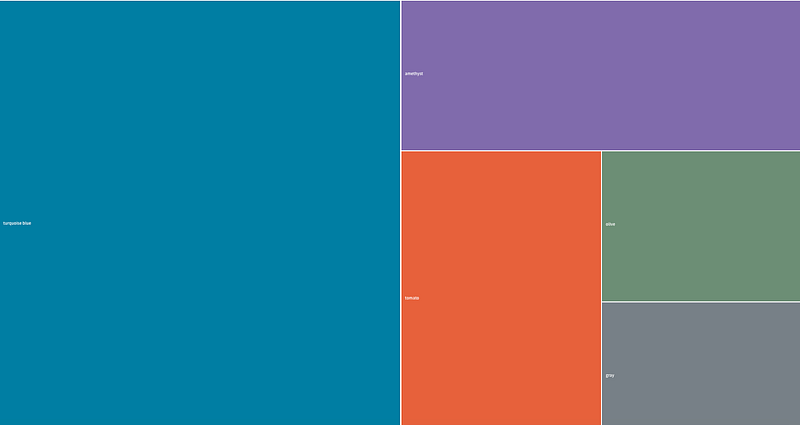
Illustrations are part of the brand look and feel:


Healthline typography guidelines are below:

The Process
The work to build out your brand identity is often undertaken with the help of a strong brand consultant or agency. Customer and prospect testing and iteration are important to get it right.
Work on brand identity is work on the essence of your being as a company. For that reason, it is very important that the entire executive team critically review and provide feedback on the brand identity document. Once defined and finalized, your brand identity is a canon that must be protected and scrupulously followed. Your top team will be the most critical protectors and evangelists. Buy-in is key.
The foundational work you do on brand identity will be expressed in your messaging schema playbooks and ultimately in thousands of messages and millions of impressions sent to your prospects and customers. Each impression will add slightly to the meaning of your brand in the minds of the people you care about most. This is the work that ensures each message resonates like a tuning fork.
Perfect pitch.
___________
1. David Aaker, Building Strong Brands, 1996
2. Thanks to top-tier messaging expert Andrea Tucker, CEO of Strategy Applied, for the “vision lock” concept

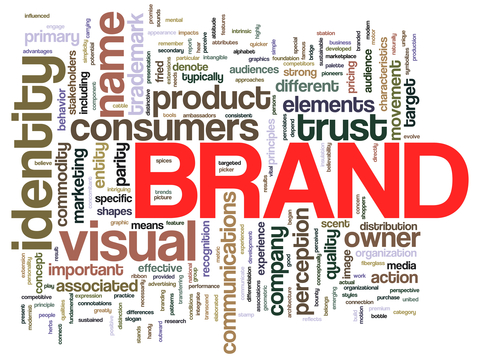
I have been checking out many of your posts and it’s nice stuff. I will definitely bookmark your website.